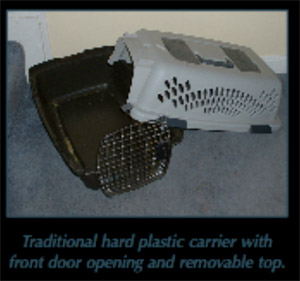Choosing a Carrier for Transport
While rabbits do enjoy staying around their homes, sometimes it’s necessary to take them to the veterinarian or to travel away from home with them. It’s important that rabbits be transported safely, and the best way to do this is by using a carrier, also known as a pet taxi. There are many different types of carriers and choosing the right one can make your life easier!
There are three main features to consider when choosing a carrier: composition, how it opens and size.

Composition is what the carrier is made of. A traditional carrier is made of hard plastic and has metal bars for ventilation. These are sturdy and travel well. There are also soft-sided carriers made out of fabric material. They usually have screens instead of metal bars for ventilation. Most people prefer the hard-sided plastic. Some rabbits will chew through the soft-sided carriers, especially if they’re in there for an extended period of time. However, the soft-sided carriers are ideal if you are in a situation where you don’t want it to be obvious that you’re transporting a pet. They look more like a gym bag. Loosely drape a towel over the carrier and you can easily hide that you have a pet. Soft-sided carriers can also be more decorative and fashionable.

Plastic carriers open several different ways. A basic, standard plastic carrier is rectangular and has a metal door that opens at one of the narrower ends. It’s pretty easy to get a rabbit inside these carriers; however, bunnies quickly master how to wedge their feet against the sides, making it difficult to take them out. For this reason, many people prefer a carrier that has a second opening on the top, where you can simply lift your rabbit out. An added advantage to this type is that you can open the top door to reach in and pet your rabbit while in the waiting area of a hospital. This model is the easiest to use, but you must also be careful about latching the top door. There have been many cases where the doors weren’t latched properly and when the carrier was picked up, it flipped sideways and opened up. There are also models that allow you to unlock and remove the entire top half of the carrier. These are usually fairly secure but can be a little more hassle than the top-door-open carriers and your bun is more exposed when the top half is off. Choosing between the three types of hard-plastic carriers is mostly a matter of personal preference.

Most soft-sided carriers have large zippered openings – just make sure the openings work for you.
Many people look at large carriers for their buns. If you’re going on shorter trips, generally under an hour, then a smaller carrier is preferable. Rabbits feel more secure in a smaller, tighter space, so you really don’t need much extra space around your bunny. You may want to go slightly larger if you think you might get a friend for your rabbit in the future. If you’re traveling on a longer trip, longer than two hours, you will want a larger carrier. You will need a way to either set up a small litter box and still have space for your rabbit to stretch out, or if you don’t use a litter box, you will need super-absorbent bedding to soak up any urine.
If you have a bonded pair, they should travel together in the same carrier – they will snuggle together for support. There are other things you can do to make the carrier more comfortable for your bun. You can cut a piece of fleece to fit the dimensions of your carrier and place it on the floor. Another option is to fold up a towel. This works fine for some buns but others will scrunch the towel and push it to the side. You can also take newspaper and lay it on the bottom of the carrier. Placing hay in the carrier will give your rabbit something to munch on. Shorter trips (under an hour) don’t require any water or additional food. For a longer trip, you should have a supply of veggies and pellets, and a small water bottle to attach to the door. I would not use a water bowl as they spill too easily.
When you place the carrier in the car, make sure it’s secure on the seat or floor. You can place the seat belt through the carrier handle to help secure the carrier in place.
In the pet store, you will see leashes for sale. As a general rule, they are not recommended for rabbits. A leash will not secure your rabbit in the car. You don’t want a rabbit jumping on your lap or trying to hop around your feet as you are stepping on the brakes. They offer no protection or security against other animals in a waiting room. Even if you aren’t going for a drive and you just want to take your rabbit out on your lawn, you need to be very careful. If you are going to use a leash, make sure you use a harness around the body, not a simple neck collar. You also need to make sure that it’s snug. Too many rabbits have slipped out of their harnesses because they were not on securely.
Choosing the right carrier can make vet visits and other transports easier!
by Suzanne Trayhan
